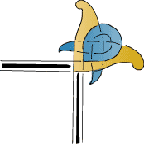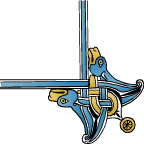
HATCHMENTS
INDEX
First
Second
Third
Fourth
Fifth
Sixth
Seventh
Eighth
Ninth
THE HATCHMENTS AT ST MARY'S
A hatchment is a painting of a coat of arms on a diamond shaped board. They came into vogue in England during the 17th century and reached their height in the 18th. Hatchments originated in the carrying of ceremonial shields and helmets (afterwards left in the church) at funerals in the 16th century, and in the earlier practice of setting up in the church the actual shield of a deceased person. These elaborate ceremonies came to an end towards the end of the 16th century and were replaced by hatchments. The word “ hatchment” is a corruption of the term “achievement” which is the heraldic term implying an emblazonment of the full armorial bearings of any person.
On the death of a person of any social position, a hatchment of his or her arms was set up over the entrance to his house, which remained there for twelve months, during the period of mourning. It was then taken down from the house and set up in the church. There does not appear to have been any obligation upon a clergyman either to permit their erection, or to allow them to remain for any specified period. In some churches they have been discarded and relegated to the vestry or to the rubbish heap, whilst in others they have been carefully preserved. Here in St. Mary’s there are nine hatchments, all in the South Aisle, hanging high above the arches and windows. On the west wall of the church near the nave is a framed illustration showing 12 hatchments, which used to hang on the walls but three seem to have been lost.
The hatchment was a diamond-shaped frame, painted black, and enclosing a painting in oils upon wood, or more frequently canvas, of the full armorial bearings of the deceased person. The frame was usually about five feet six in height and the rules for the display of arms upon hatchments afford an interesting set of regulations that may be applied to other heraldic emblazonments. The chief point, however, concerning a hatchment, and also the one in which it differs from an ordinary armorial emblazonment, lay in the colour of the groundwork upon which the armorial bearings were painted. For an unmarried person the whole of the groundwork was black, but for a husband or wife half was black and half white, the groundwork behind the arms of the deceased person being black, and of the surviving partner in matrimony white. The background for a widow or widower was entirely black.
